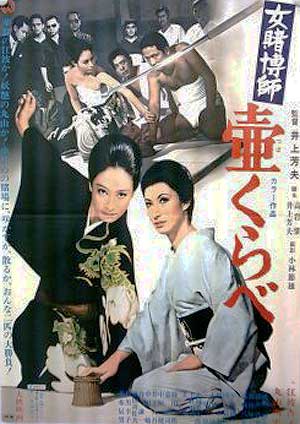 Kyoko Enami plays Ogin (or Ginko-den) in Daiei Studio's long-running Woman Gambler series that began with Onna tobakushi (The Woman Gambler; aka, Woman Gambling Expert, 1967). Kyoko Enami plays Ogin (or Ginko-den) in Daiei Studio's long-running Woman Gambler series that began with Onna tobakushi (The Woman Gambler; aka, Woman Gambling Expert, 1967).
This episode includes supporting performances from Kojiro Hongo, Saeda Kawaguchi, & Rhyohei Uchida. Kyoko Enami as the central character is a slim elegant actress with a serious demeanor & an absolutely fabulous collection of stately kimonos. She's wonderful in the role.
The series gets cited on lists of action yakuza films or woman avenger films, but once the films are actually viewed, it is quickly obvious they are not generally about action except in the nominal sense of acts of gambling. And while Ogin is in fact sometimes motivated by revenge, she is not as a rule a martial artist or a killer, & this series tends to place its female hero as far away from the "action babe" method as she can get.
Ogin is an honest dealer in the criminal underworld of yakuza-run gambling. She is samurai-like in that she sets out to become Japan's number one dealer, much as a samurai might go on his "warrior's pilgrimage" to become Japan's number one swordsman.
On those occasions when she fails, her real failure was only in not having seen through someone's method of cheating, & when she does uncover the method to reestablish her preeminance as a dealer, her adversary may well be forced to commit suicide or otherwise be punished.
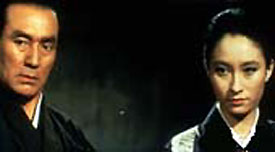 The episode Onna tobakukushi tekkaiba yaburi (The Woman Dicer; aka, Woman Dicer's Revenge, 1968) has supporting performances by Ryutaro Otomo, Mikio Narita, Goro Tarumi &ajmp Chisako Hara. The episode Onna tobakukushi tekkaiba yaburi (The Woman Dicer; aka, Woman Dicer's Revenge, 1968) has supporting performances by Ryutaro Otomo, Mikio Narita, Goro Tarumi &ajmp Chisako Hara.
For her ability to spot cheats, Ogin gains some notice & is given a chance to rise as a dicer. She meets a woman dicing instructor who can personally no longer participate at gaming mats, having lost a finger for cheating. As a teacher who cannot herself rise in the yakuza world, she wants to live her dream through Ogin, promising, "I will make you astounding," & does so.
Although there is a tiny bit of fighting & bloodletting here & there throughout the series, usually performed by men around her, the focus throughout these films is on Ogin's skills as a gambler & especially as a flower-card dealer or a dicer. Defeating her opponents at gambling is the same as winning a swordfight, & a passionate sense of honor can rest on every game.
Ogin rarely engages in battles as does Fuji Junko in the Red Peony Gambler series, though Shin Onna tobakushi-hada (New Woman Gambler, 1971) had chambara director Kenji Misumi on board for the first time & he decided to put a sword in Ogin's hand for the climax, perhaps in an effort to regain audience numbers as the chivalrous yakuza films were winding down in popularity. Misumi's only episide was to be the series finale.
For most of the series, the excellence is not in bloody action but in mood, tone, attitude, training, the romanticization of traditions preserved within the gambling world, beauty of costume, Ogin's extreme seriousness of demeanor, even the dramatic score & gorgeous cinematography in scope & vibrant color.
These are visually beautiful films with their dramatic soundtracks, but the pacing is deliberate & the aesthetic probably alien to most western viewers.
 I think some of these are splendid films in their own right, but they go the opposite direction from action so will not please everyone who expects a yakuza film to have at least one big battle with guns or swords before the last reel runs its course. I think some of these are splendid films in their own right, but they go the opposite direction from action so will not please everyone who expects a yakuza film to have at least one big battle with guns or swords before the last reel runs its course.
Because that's not what these films deliver, they're almost totally unknown in the west, though rarely shown subtitled 35 mm prints exist in the states, & it's a little surprising this series has not been more noticed by the truly serious devottees of classic yakuza cinema, of which there remain more than a few.
Unfortunately Enami is known to J film fans in the west mainly for her appearance in the monster movie Daikaiju kessen: Gamera tai Barugon (Gamera vs. Barugon aka War of the Monsters aka Great Monster Battle, 1966) in which she plays a vampire. It's a laughable role that does not convey her extraordinary dignity when playing Ginko-den, even though Gamera vs. Barugun was directed by one of Kyko Enami's best Woman Gambler directors, Shigeo Tanaka, beginning with the third in the series, Onna Tobakushi Zetsuenjo (Woman Gambler III, 1968).
Her later career was as a character actress in films & a star of television dramas, & as she ages she seemed not to be interested in promoting her old gambling-world epics.
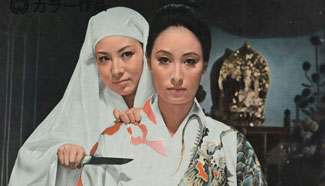 Shigeo Tanaka directed one of the coolest episodes, Onna tobakushi amadera kaicho (The Woman Gambler & the Nun, 1968), with supporting performances from Mako Sanjo, Yasuke Kawazu & the greatest of great character actors, Takashi Shimura. Shigeo Tanaka directed one of the coolest episodes, Onna tobakushi amadera kaicho (The Woman Gambler & the Nun, 1968), with supporting performances from Mako Sanjo, Yasuke Kawazu & the greatest of great character actors, Takashi Shimura.
The Onna Tobakushi series often doubles back & starts its primary themes anew, rather than projecting the character of Ogin always forward in an evolving history. This time Ogin is once again a gambler's daughter on the rise to fame in the gambler's world, newly a top dealer. Her father, however, is a compulsive cheater who wants Ogin to test all his clever cheating methods in big games, though her gut-level sense of honesty & fairplay make her balk.
Differences in each series episode are often subtle & have to be appreciated for the subtleties. Usually Ogin is ultra-honest from the start, even in world full of crooks, & if anyone can defeat her it's because they are really good cheaters who will eventually be revealed. In The Woman Gambler & the Nun, however, Ogin is herself a cheater because of her father's insistence, & only toward the end does she overcome his control of her & set out to defeat her gambling opponent fairly.
Her nemesis is "Crimson Cherry Rie," a famous woman gambler on the skids due to alcoholism. Rie becomes a nun in the course of the film, practicing her gaming techniques in the convent so that she can become good enough to defeat Ogin.
Meanwhile, Ogin has been blackballed by an evil gambling boss, so that she can only play in small-time glambling establishments unless & until she agrees to work for the appalling bad-guy.
The bad guy is trying to take over the business & property of an honest man (played by Takashi Shimura, the head-shaved samurai in Seven Samurai). In the ending scene, Ogin & Crimson Cherry Rie are faced off with the bet being this: If Ogin wins, the evil boss will not foreclose on Shimura's business for three months, giving him the chance to clear his debt. If Crimson Cherry wins, then Ogin will leave the gambling world forever unless she elects instead to be the bad guy's mistress.
What Ogin doesn't know is that her father has been murdered & his "super dice" stolen, the same dice she had refused to use. He had designed them to roll odd numbers a certain number of times, then even numbers a certain number of times. During the game, Ogin recognizes the pattern & uncovers the cheating methods, but the bad boss refuses to give up his claim against the honest man's property & tries to kill Ogin.
Her long-lost half-brother, a tragic minor character in the plot, arrives in the nick of time to fight off the bad guys & give a happy ever after ending, with sorrowful undertones. He won't admit he's her brother (even Shimura says, "He's not your brother! Your brother isn't a drifter like that!"). He tells her, "Be the best woman gambler in Japan" before walking off into the distance.
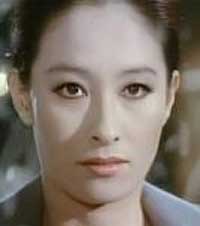 The immediate sequel to The Woman Gambler & the Nun was also directed by Shigeo Tanaka, The Woman Gambler's Supplication (Onna tobakushi midare-tsubo, 1968), with support roles from Chieko Naniwa Iamu Nagato, Michiyo Yasuda, Utako Kyo & Keisuke Otori. The immediate sequel to The Woman Gambler & the Nun was also directed by Shigeo Tanaka, The Woman Gambler's Supplication (Onna tobakushi midare-tsubo, 1968), with support roles from Chieko Naniwa Iamu Nagato, Michiyo Yasuda, Utako Kyo & Keisuke Otori.
The gambling nun & arch-rival of Otaki Ginko (or "Climbing Dragon Ogin") makes her return in this episode, still trying to prove herself Ginko's better, & still failing. The Woman Gambler's Supplication varies from the norm of the series in that there is no cheating method for Ginko to uncover. The super-dealer Tomozo, unbeatable at cards or dice, is completely above-board & honest this time.
For once Ginko is up against someone who is simply better than she is. Thus she takes to the road again, promising to return at year's end for the annual contest to decide which gang wins control over the Dharma festival, vowing to improve her skills so that she can defeat Tomozo & regain the festival rights for her own boss.
In the course of events, Tomozo obtains an ear injury &, by the time of the final "duel of flower-cards," Ginko has some idea that she can take advantage of Tomozo's recent handicap. However, Ogin makes no effort to use this privileged knowledge, as she desires to win without resorting to any advantage, causing Tomozo to be hugely impressed by the depth of her honor, though also utterly depressed by the defeat.
A rather poor swordfight is staged at the end, the losing boss attacking Ginko & her boss, with Tomozo stepping in & killing the evil nasty fellow. Since other yakuza series nearly always ended with a duel, this got tacked on to a Woman Gambler episode a mite clumsily.
It's not a great film, but if one gains a liking for the character of Ginko & the slim proud presence Kyoko Enami presents within this character, there's always the star to appreciate, & it's especially appealing to see her offered the chance of an advantage that might not quite be cheating, but she even so won't do it.
There is, however, one side-story that raises the merits of this episode, the tale of a go-go dancer who wanted to become a top dicer just like Ginko, & whose old mother had been a famous gambler in her day. There are some powerful interchanges between the mother, the go-go dancer, & Ginko which provide wonderfully positive portraits of women helping one another in strong, emotional ways inside the yakuza underworld.
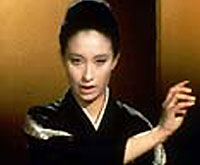 Ogin's stories are set in the 1960s or contemporary to when the films were made. In Onna tobakkushi hanano kirifuda (The Woman Gambler's Trump Card, 1969), there is occasional violence & shortswords come to bare, but as always in these films, the "duels" are with cards or dice, not weapons.
Ogin's stories are set in the 1960s or contemporary to when the films were made. In Onna tobakkushi hanano kirifuda (The Woman Gambler's Trump Card, 1969), there is occasional violence & shortswords come to bare, but as always in these films, the "duels" are with cards or dice, not weapons.
In Trump Card the games are honbiki & tehonbiki played with the stiff little hanafuda cards with which an opponent has a one in six chance of guessing a face card correctly, each depicting a different flower & contributing by their beauty to the general sense of elegance these films like to suppose goes along with gambling (an elegance always in competition with the sleeze).
In sundry episodes of the series various games are focused upon, but all the films deal with the same couple of elements, beginning with a "good" boss losing his territory during the yearly play-offs to see which gang controls certain gambling regions & festivals, & a very bad dishonest yucko boss gets the territory instead. Trump Card begins with Ogin being the reason territory was forfeited, as she was the dice shaker at the deciding game. Generally when Ogin loses it's because some cheated, but in this case her opponent, Asazo, is honest & genuinely superior.
The boss who lost his territory committed suicide, leaving Ogin a tremendous sense of guilt & a difficult mission to make ammends for having lost. In other episodes the boss, or her father, is murdered, & she must avenge the death by defeating the dicer who is her nemisis, revealing his cheating methods, so that he'll commit suicide on the spot, but in this case Ogin genuinely needs to improve her skills, as happens to her now & then because the training sequences are so important to the series.
There will nevertheless also be a cheat for Ogin to expose, thanks to a little plot complication. Her honest nemesis Asazo gets attacked & injured so that he can never be a shaker again. His replacement, Hanji, is crooked as they come, a slight-of-hand artist whom Ogin will unmask by tossing her pin through his hand, pinning the palmed cards together.
The gambling duels are intense but Trump Card like all these films, by their very nature, are slow moving & repetitious. But these films are great to use as "breathers" between the more action-oriented yakuza films, & they are more than commonly informative about the yakuza world's rules & methods (imagined or real).
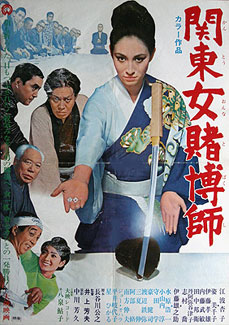 Expert gambler "Climbing Dragon" Ogin was by no means the only such character Kyoko Enami created on the screen. In Onna kumicho (The Geisha Firefighter, 1970) she plays a female oyabun (boss) of firefighters, whose culture was bound up in the origins of yakuza culture & tattoo culture.
Expert gambler "Climbing Dragon" Ogin was by no means the only such character Kyoko Enami created on the screen. In Onna kumicho (The Geisha Firefighter, 1970) she plays a female oyabun (boss) of firefighters, whose culture was bound up in the origins of yakuza culture & tattoo culture.
She has first billing in films with multiples of women gamblers in Sanbiki no onna tabakushi (Thoroughbred Women Gamblers, 1967) & Onna toba-arashi (The Sister Gamblers, 1967).
A few of the one-offs have swordplay action & are more in keeping with the "usual" ninkyo films. One of Enami's best was Kanto Woman Gambler (Kanto Onna Tobakushi, 1968), with posture shown here. It has a great cast including Takashi Shimura & Kunie Tanaka.
Though once again the box office receipts weren't sufficient to justify spinning it into a whole series, although there was to be a different Kanto Woman Gambler series (1968-69), four films starring Michiyo Yasuda.
Another example was Showa onna jingi (Daiei, 1969), variously known in English as The Woman Killer; aka, Showa Woman's Duty; or, Showa Woman's Gambling Code.
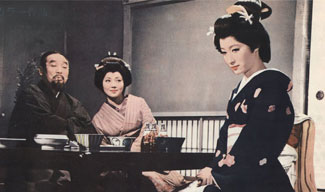 Enami plays Tomoko Kumoi, a modern day gambler dressing habitually in traditional kimono. Enami plays Tomoko Kumoi, a modern day gambler dressing habitually in traditional kimono.
In this characterization, her garments are more somber than when she played Ogin, for Tomoki is an ex-geisha on a mission of vengeance for her betrayed & murdered lover (Yusuke Kawazu), a yakuza of the Horikawa gang. Also featured is her recurring co-star, Mikio Narita.
in one great scene, she is working in a sleezy gang-controlled bar as a performer. In her act, clad as a samurai, she does a remarkable sword dance.
By the end of the tale, she has solved the mystery of who her lover's murderer was, & exacted a bloody revenge, without remorse, & probably will never be caught by the police.
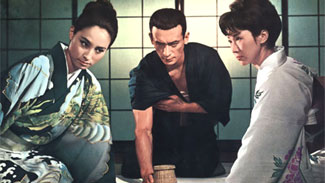 Showa onna jingi was almost certainly intended as the first of a series, but there were no sequels. Showa onna jingi was almost certainly intended as the first of a series, but there were no sequels.
Showa onna bakuto (Modern Woman Gambler, 1972) was the last such character she played, among several along the way. The whole ninkyo or chivalrous gambler fad was fading away, & the top female yakuza player, Junko Fuji, had just retired in 1972.
Showa onna bakuto was one of several pilot efforts for various series with various actresses, but the time for this sub-genre had passed. Of the pilot films which tried to become the new Red Peony Gambler, none launched any new chivalrous woman gambler type series for the 1970s.
This last try for Enami had top director Tai Kato. Her co-star was the perenially popular Hiroki Matsukata. And the former success of Ogin the Woman Gambler films must've made Kyoko Enami seem a sure-thing for finding that Junko Fuji replacement.
Some of these films were very, very good, but only the ones that had sex & torture did any box office in the '70s, so soon there were no more of the good ones that treated gambling heroines seriously & with respect.
Following below is a list of the "Onna Tobakushi" Woman Gambler feature film episodes, for which I welcome corrections.
THE EXPERT WOMAN GAMBLER SERIES:
ONNA TOBAKUSHI
(THE WOMAN GAMBLER) 1967
Directed by Taro Yuge
ONNA TOBAKUSHI ZETSUENJO
(CHAMPION WOMAN GAMBLER) 1968
Directed by Shigeo Tanaka
ONNA TOBAKUSHI TEKKABA YABURI
(THE WOMAN DICER
aka, WOMAN DICER'S CHALLENGE) 1968
Directed by Yoshio Inoue
ONNA TOBAKUSHI OKUNOIN KAICHO
(THE WOMAN GAMBLER'S REVENGE) 1968
Directed by Yoshio Inoue
ONNA TOBAKUSHI NORI-KUMO
(THE WOMAN GAMBLER IS COMING) 1968
Directed by Shigeo Tanaka
ONNA TOBAKUSHI AMADERA KAICHO
(WOMAN GAMBLER & THE NUN) 1968
Director: Shigeo Tanaka
ONNA TABAKUSHI MIDARE-TSUBO
(THE WOMAN GAMBLER'S SUPPLICATION) 1968
Directed by Shigeo Tanaka
ONNA TOBAKUSHI JUBAN SHOBU
(THE WOMAN GAMBLER'S TENTH GAME) 1969
Director: Shigeo Tanaka
ONNA TOBAKUSHI SAI-KOKORO KESHO
(WOMAN GAMBLER: DICE MAKE-UP) 1969
Director: Yoshio Inoue
ONNA TOBAKUSHI CHOHAN TABI
(FEMALE TRAVELLING DICER) 1969
Director: Yoshio Inoue
ONNA TOBAKUSHI HANANO KIRFUDA
(THE WOMAN GAMBLER'S TRUMP CARD) 1969
Director: Yoshio Inoue
SHIN ONNA TOBAKUSHI TSUBOGUREHADA
(THE WOMAN GAMBLER'S IRON RULE) 1971
Director: Kenji Misumi
copyright © by Paghat the Ratgirl
|
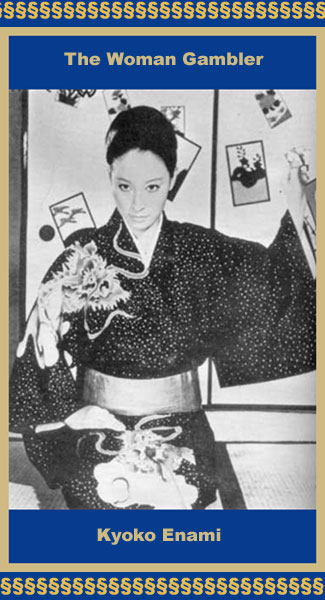


 I think some of these are splendid films in their own right, but they go the opposite direction from action so will not please everyone who expects a yakuza film to have at least one big battle with guns or swords before the last reel runs its course.
I think some of these are splendid films in their own right, but they go the opposite direction from action so will not please everyone who expects a yakuza film to have at least one big battle with guns or swords before the last reel runs its course.



 Enami plays Tomoko Kumoi, a modern day gambler dressing habitually in traditional kimono.
Enami plays Tomoko Kumoi, a modern day gambler dressing habitually in traditional kimono. Showa onna jingi was almost certainly intended as the first of a series, but there were no sequels.
Showa onna jingi was almost certainly intended as the first of a series, but there were no sequels.